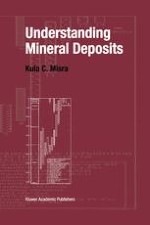2000 | OriginalPaper | Buchkapitel
Porphyry Deposits
verfasst von : Kula C. Misra
Erschienen in: Understanding Mineral Deposits
Verlag: Springer Netherlands
Enthalten in: Professional Book Archive
Aktivieren Sie unsere intelligente Suche, um passende Fachinhalte oder Patente zu finden.
Wählen Sie Textabschnitte aus um mit Künstlicher Intelligenz passenden Patente zu finden. powered by
Markieren Sie Textabschnitte, um KI-gestützt weitere passende Inhalte zu finden. powered by
The most well known among the porphyry-type deposits are the porphyry copper deposits. Originally, the term porphyry copper was applied to stockwork copper mineralization in felsic, porphyritic igneous intrusions. With the development of large-scale open-pit mining methods and froth flotation techniques for efficient beneficiation of low-grade ores, the meaning of the term has been expanded to include economic considerations as well as engineering characteristics. It now refers to large (many with hundreds of million tonnes of ore), relatively low-grade (commonly <1 wt% Cu), epigenetic, intrusion-related, disseminated (stockwork), hypogene copper deposits that can be exploited by bulk-mining techniques. Similar large-tonnage and low-grade disseminated deposits related to igneous intrusions are also important for molybdenum (porphyry molybdenum) and tin (porphyry tin), and constitute part of the potential resources of uranium (porphyry uranium) and gold (porphyry gold). Association with porphyritic rocks is not considered an essential component of the definition of porphyry deposits, but the related intrusions almost always contain one or more porphyritic members, implying an epizonal environment (less than 5 km depth) of emplacement of partly crystallized magmas. Other common characteristics of the porphyry-type deposits include a large hydrothermal system dominated by magmatic ± meteoric fluids, pervasive hydrothermal alteration of host rocks, fracture-controlled ore mineralization, and association with breccias of diverse origins and variable degrees of mineralization. In this chapter we will focus on porphyry copper and porphyry molybdenum deposits.
